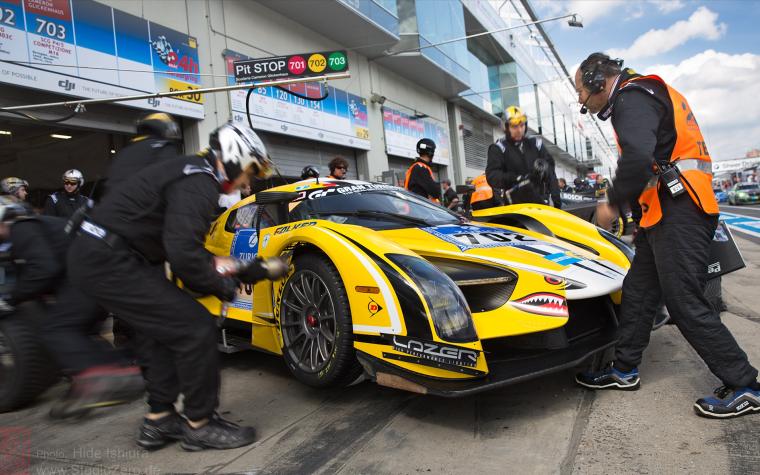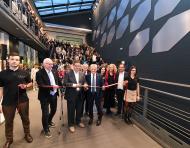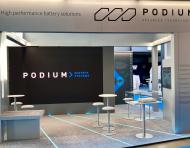News
Overview of the 2016 SCG 003C European racing season
24 Oct 2016
Pont Saint Martin, 24 October 2016 - The SCG 003C prototype developed by Podium Engineering debuts into the European 24H Series finishing day one of the Mugello 12H in second position overall, and keeps claiming positive results at the Nürburgring.
The following are excerpts from various Scuderia Cameron Glickenhaus press releases, issued during the 2015 racing season:
Mugello 12 Hours - 18 March 2016
Scuderia Cameron Glickenhaus debuts into the 24H Series and finishes day one of the Mugello 12H in second position.
Both Scuderia Cameron Glickenhaus cars (701 and 702) started the first four hours of the race in great shape. Starting from 13th and 11th on the grid respectively, the drivers were able to pick off the competition one by one, with both cars holding top spot at points during the race.
Unfortunately, on Saturday, with two hours left of racing, Scuderia Cameron Glickenhaus has had to retire both vehicles (701 and 702) due to gearbox issues despite a strong start, particularly for car 702.
This was the first official race of 2016 for Scuderia Cameron Glickenhaus and the first time the team competed in the 24 Hour Series, and at the Mugello circuit.
VLN 1 – 2 April 2016
Scuderia Cameron Glickenhaus had a disrupted start to its 2016 racing campaign at the Nordschleife.
Heavy snowfall overnight resulted in a delayed start to the initial test session prior to the opening round of the VLN series. Test session 1 did not start until 13h00 in order for overnight snow and ice to melt on the Nordschleife. The second session was red flagged before Jeff Westphal was able to complete one full timed lap of the Nordschleife despite leaving the pit lane the moment the session began. An accident on the Nordschleife then prompted the red flags at 17:19, with the session finally halted at 17:45.
The team qualified in 24th position, but the session was cut short when Thomas Mutsch made contact with the barriers on the Nordschleife. Mutsch completed his lap in order to qualify and then immediately returned to the pits. Macchinadue had suffered some damage to the steering rack and bodywork, presenting the team with only a two hour window to repair the car in order to start the race. The SCG mechanics faced a difficult challenge, working tirelessly to repair MacchinaDue in time for Jeff Westphal to start the race at the back of the first pack via the pit lane.
Opening the race for the team, Westphal started in 65th position, making good progress through the field before handing over to Andreas Simonsen after seven laps. Simonsen rejoined the race in 58th position and started charging up the order. Ultimately Simonsen’s fast pace led him to reach 29th position at the start of SCG’s 16th lap, before being hampered by an exhaust issue with 90 minutes of the race remaining.
Facing competition from over 160 cars and over 400 drivers including 2015 Le Mans winner Earl Bamber, SCG displayed the SCG 003C’s true performance potential. This could be seen towards the end of Simonsen’s stint, delivering lap times worthy of the top 10 in the race. SCG retired car 702 at 16:00.
Qualifying race - 17 April 2016
SCG welcomes some new drivers for this round, who will also drive in the 24-hour race. Recently announced Top Gear presenter and star of his own YouTube channel Chris Harris is behind the wheel on the debut of the P4/5 C Mk III (numbered 703) along with Evo journalist Jethro Bovingdon. Supporting the pair is regular SCG driver Manuel Lauck.
Behind the wheel of SCG 003C MacchinaUno, numbered 701, is Manuel Lauck (driving two cars this weekend), Jeroen Bleekemolen and Franck Mailleux.
Thomas Mutsch, Jeff Westphal, and Andreas Simonsen are driving SCG003C MacchinaDue numbered 702. Felipe Laser is taking part in qualifying, with both cars.
P4/5 C Mk III is the 2016 evolution of the P4/5 Competizione M that raced the Nürburgring 24 Hours in 2012 in the Hybrid cars category. Compared with the 2012 version, the new model has got an updated battery pack, a new electronic control module – developed by SCG partner Podium Engineering – as well as a new engine. The new unit is a 4.300 cc V8 Ferrari derived engine.
VLN 2 – 28 April 2016
Entered for the second round of the VLN championship are the two SCG 003C that will also compete at the 24 Hours: MacchinaUno and MacchinaDue. The crew of MacchinaUno will consist of Jeroen Bleekemolen, Manuel Lauck and Franck Mailleux. At the wheel of MacchinaDue will be Thomas Mutsch, Andreas Simonsen and Jeff Westphal. Alternating between the two cars will be Felipe Laser.
The second round of the VLN championship was an extremely successful outing for Scuderia Cameron Glickenhaus, with MacchinaDue crewed by Thomas Mutsch, Andreas Simonsen and Jeff Westphal finishing first in class.
After a strong start from Mutsch they soon hit the top of the SPX class, and stayed there to dominate the category, running within the top 10 overall as well. By the end of the race, the car was classified 12th.
The biggest challenge over the weekend was the changeable weather conditions, which ranged from sunshine to rain to sleet, meaning that quick-thinking decisions had to be made on the pit wall with regard to strategy and tyre choices. The length of a lap of the Nürburgring and Nordschleife inevitably means that any wrong decision has far-reaching consequences, so success in the four-hour race was as much of a triumph for SCG’s strategists as it was for the drivers.
MacchinaUno also showed big potential, with a strong qualifying pace and top-six performa
nce before being halted by a mechanical problem halfway through the race. Although the team could have continued, it elected to stop and conserve the car for the forthcoming 24-hour race. MacchinaUno’s sheer speed was shown in the opening two laps, when Frenchman Franck Mailleux, who was sharing the car with Jeroen Bleekemolen and Manuel Lauck, made up a remarkable 20 places.
Nürburgring 24 Hours – 28 May 2016
Scuderia Cameron Glickenhaus completed the ADAC Zurich 24-Hour Race in the top 30. The legendary 24-Hour race at the Nürburgring has been completed by SCG003C MacchinaDue (number 702), following a brilliant effort from Scuderia Cameron Glickenhaus and its drivers.
A total of 158 cars started the race and just 101 managed to complete it, with MacchinaDue (702) classified 26th.
At the start of the race, MacchinaDue (702) lined up in 23rd place on the grid, with MacchinaUno (701) in 34th spot.
Due to some unprecedented weather conditions, including hail and ice, the race was suspended after just six laps of action. It restarted at 19.20 with MacchinaDue (702) starting 21st on the reformed grid and MacchinaUno (701) 23rd.
MacchinaDue (702), with a registered driver crew of Jeff Westphal, Thomas Mutsch, Andreas Simonsen and Felipe Laser, started particularly well and managed to run as high as fourth overall at one point during the night. It was consistently among the fastest lappers and set the best lap in its class when Andreas Simonsen was behind the wheel at 07.46 in the morning (at an average of 180.15 kph).
MacchinaUno (701) was crewed by Manuel Lauck, Felipe Laser, Franck Mailleux and Jeroen Bleekemolen. This supremely experienced crew also made up a number of places throughout the race to run in the top 10.
However, during the night both cars experienced a similar turbo problem that broke the exhaust in an especially tricky place. Despite the complexity of the situation the SCG mechanics did a fantastic job to repair both cars, spending about an hour in the pits to deal with this issue.
Thanks to some brilliant driving and strategic decisions by the team, MacchinaDue (702) made it through the race, continually moving up the order when it was in full health to finish in 26th spot, completing a total of 119 laps (or more than 3000 kilometres).
MacchinaUno (701) regained a number of places but unfortunately the car was involved in a collision at Metzgesfeld with just an hour and a half to go, through no fault of its own. It was damaged beyond repair, rendering it unable to finish the race.
VLN 8 – 24 September 2016
Scuderia Cameron Glickenhaus has scored its best result to date in an uninterrupted VLN race, with fourth overall at the latest four-hour race on Saturday.
In the past, the team has claimed second overall – but this was following a race that was affected by red flags and stoppages. The latest result was achieved in a non-stop sprint against the best-known sportscar manufacturers in the world.
The team fielded two cars at round eight of the VLN: number 701 for Germany’s Felipe Laser and Frenchman Franck Mailleux, and 702 for Thomas Mutsch from Germany and Jeff Westphal from the USA.
The cars qualified in 10th and 17th places respectively, and showed perfect mechanical reliability, as well as front-running pace, from start to finish. While 701 finished just off the podium, beaten only by the latest cars from Porsche and Mercedes that were crewed by factory drivers, 702 was delayed by a bodywork issue and a punctured tyre.
VLN 10 –22 October 2016
Scuderia Cameron Glickenhaus has completed the last race in the VLN Championship at the legendary Nürburgring finishing first in class and seventh overall.
SCG fielded one car, MacchinaDue (702), driven by Felipe Laser and Thomas Mutsch, both from Germany. It was a very positive weekend for the team, which started the four-hour race from ninth on the grid in wet conditions with Felipe behind the wheel.
As the track became drier throughout the race the tire strategy worked well meaning that the team finished in seventh position overall and first in its class.


